My first DBJ tests from a previous post on knitting with elastic. used an axometric shape, with the tentative repeat worked out and in turn, elongated X2 and tiled to check alignment.![]()
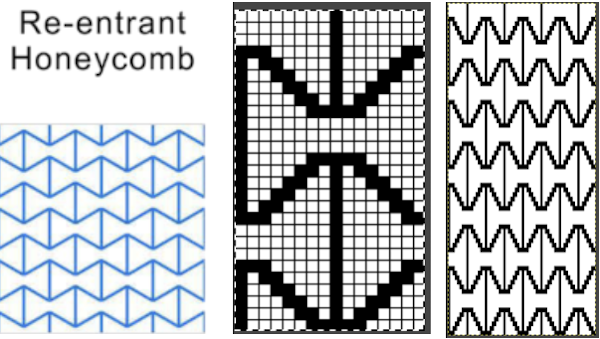 Until doubled in height the original repeat is composed of an odd number of rows in height. Usually, double bed knitting relying on color changes or automatic DBJ KRC separations require an even number of rows in the motif. The first sample was knit using single-ply cotton and elastic yarns respectively, fed through separate upper tension disks but knit together as a single color. The swatch is 72 stitches in width but measures only 14.5 mm (5.7 inches) in width, producing a gauge of nearly 13 stitches for inch, not achievable when knitting with standard fibers on a standard 4.5 mm machine. The pattern is subtle, more visible on the knit side, hard to tell there are pockets in the knit. The cotton is space-dyed, and as true when using such yarns, that causes some confusion in immediately identifying a clear pattern. The ruffled effect is simply from a plain knit start and color-changing stripes to test tension and knittability on the planned needle width. Machine settings: opposite part buttons, no lili
Until doubled in height the original repeat is composed of an odd number of rows in height. Usually, double bed knitting relying on color changes or automatic DBJ KRC separations require an even number of rows in the motif. The first sample was knit using single-ply cotton and elastic yarns respectively, fed through separate upper tension disks but knit together as a single color. The swatch is 72 stitches in width but measures only 14.5 mm (5.7 inches) in width, producing a gauge of nearly 13 stitches for inch, not achievable when knitting with standard fibers on a standard 4.5 mm machine. The pattern is subtle, more visible on the knit side, hard to tell there are pockets in the knit. The cotton is space-dyed, and as true when using such yarns, that causes some confusion in immediately identifying a clear pattern. The ruffled effect is simply from a plain knit start and color-changing stripes to test tension and knittability on the planned needle width. Machine settings: opposite part buttons, no lili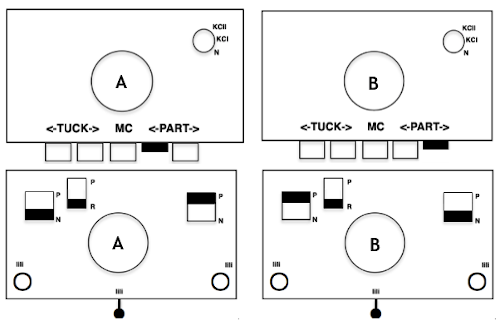
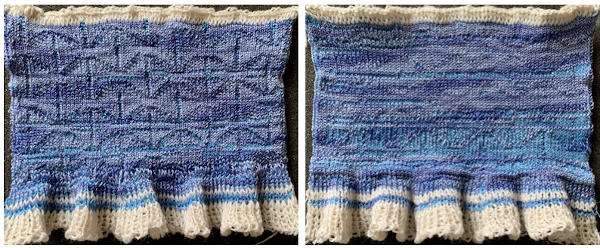 Here the same pattern was executed on the same number of stitches with the white wool used above, but the elastic was plied with a 2/24 acrylic yarn and knit as DBJ with the blue, stretchy combination creating the solid color backing.
Here the same pattern was executed on the same number of stitches with the white wool used above, but the elastic was plied with a 2/24 acrylic yarn and knit as DBJ with the blue, stretchy combination creating the solid color backing.  A comparison in scale
A comparison in scale 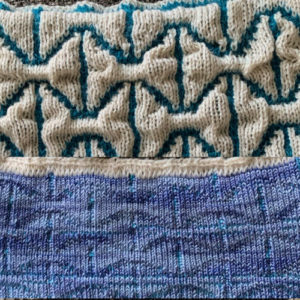 The same pattern repeat knit with striper backing is far less interesting
The same pattern repeat knit with striper backing is far less interesting 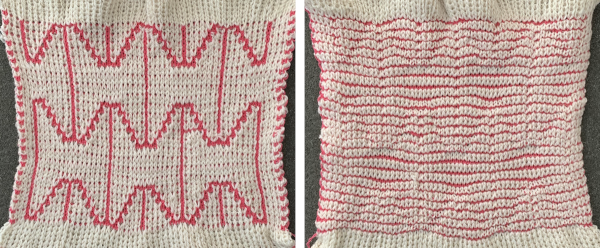
The solid color backing in DBJ can be produced by changing ribber settings with each color change from N/N to slip <– –> and back. I have sometimes knit DBJ with 4 carriages or with a third, knit-only carriage working the rows normally slipped by the ribber. The sinker plate for one knit carriage is altered as described in the post. The knitting requires that the ribber stops be removed, and that carriage(s) be off the bed on extension rails while the other(s) are in use so as not to damage the belt. The maximum width of the fabric is limited by the necessity of having the knit cleared on both sides with all carriage passes.
My mongrel setup includes a 930 bed, an 892 punchcard carriage with a magnet attached coupled with the 850 ribber carriage, and a 910 carriage with the modified sinker plate. As a bit of possible disaster prevention, the knit/ribber combo has an elastic to ensure the ribber stays on its own bed as well, while I grabbed extras to help support the rail on the other side just in case the 910 carriage went too far. 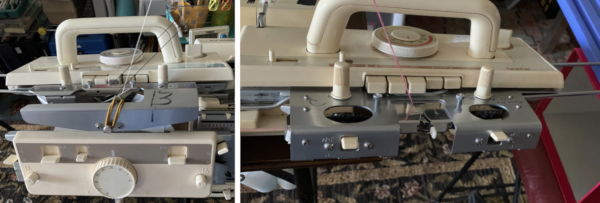 Because when using the KRC separation the white squares knit first, I planned the repeat for 64 stitches color reversing the repeat used the FI and thread lace samples in the previous post.
Because when using the KRC separation the white squares knit first, I planned the repeat for 64 stitches color reversing the repeat used the FI and thread lace samples in the previous post.![]() to this,
to this,  I used a 2/18 wool at tensions 3/3 for the backing fabric and two strands of the elastic with no added changes to its yarn mast tension, at tension 7 in the single knit carriage.
I used a 2/18 wool at tensions 3/3 for the backing fabric and two strands of the elastic with no added changes to its yarn mast tension, at tension 7 in the single knit carriage.
Using this method of DBJ, which is the same as that used in 2 color quilting, when the ribber and knit carriage both knit, the fabric is sealed where there are needles selected on the main bed. When the ribber is set to slip in both directions, or the method here is used, the main bed only knits selected needles and skips the nonselected ones, creating floats and pockets in the fabric in those areas. 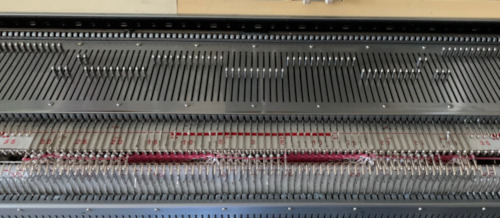
 The appearance of the fabric when stretched and weighted, still between the beds
The appearance of the fabric when stretched and weighted, still between the beds 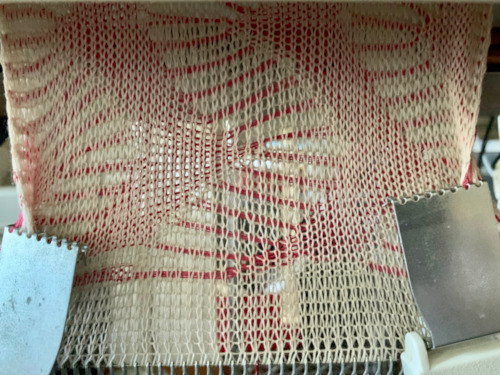 and off
and off  Going the far more traditional route of traditional dbj with the use of the color changer, striper backing with the ribber set to N/N yields a wider, flatter fabric with an interesting purl side
Going the far more traditional route of traditional dbj with the use of the color changer, striper backing with the ribber set to N/N yields a wider, flatter fabric with an interesting purl side  while my very brief effort at attempting to knit with one side of the ribber set to knit, the other to slip, met with immediate dropped stitches by the elastic.
while my very brief effort at attempting to knit with one side of the ribber set to knit, the other to slip, met with immediate dropped stitches by the elastic.  The birdseye version had more of a bent on
The birdseye version had more of a bent on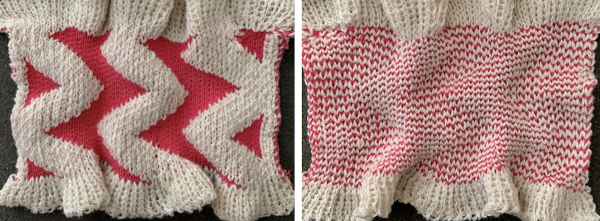 the surfaces of both colors. I stopped knitting when a few of the elastic stitches on the left purl side dropped off. It would appear at this point that the most interesting effects in the simplest to execute DBJ setting are ones with balanced positive and negative spaces in the design.
the surfaces of both colors. I stopped knitting when a few of the elastic stitches on the left purl side dropped off. It would appear at this point that the most interesting effects in the simplest to execute DBJ setting are ones with balanced positive and negative spaces in the design.
Previously I used the repeat on the top left, also shown tiled. The subsequent swatch was knit using the bottom 66X22 tiled repeat, planning to start KRC preselection from the left on a white square, the ribber set to N/N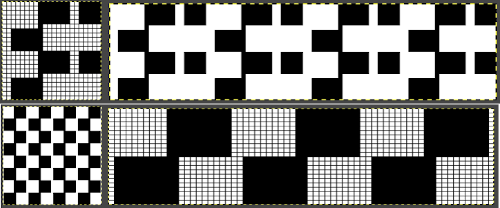
![]() I found the fabric attractive on the purl side, but I was having issues with dropped stitches I could not explain that would need sorting out if producing larger swatches.
I found the fabric attractive on the purl side, but I was having issues with dropped stitches I could not explain that would need sorting out if producing larger swatches. 
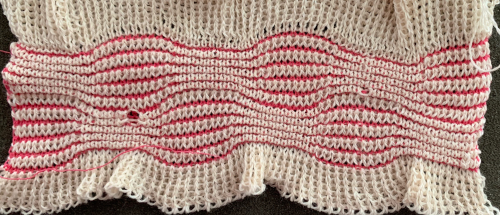 Adding a third ply of elastic was disastrous at any tension. Better results occurred simply by increasing the ribber tension by 2 whole numbers, the knit tension by 1, and reverting to the previous yarn usage. There is a single dropped stitch in the elastic, and the result has much more of a 3D effect.
Adding a third ply of elastic was disastrous at any tension. Better results occurred simply by increasing the ribber tension by 2 whole numbers, the knit tension by 1, and reverting to the previous yarn usage. There is a single dropped stitch in the elastic, and the result has much more of a 3D effect. 
